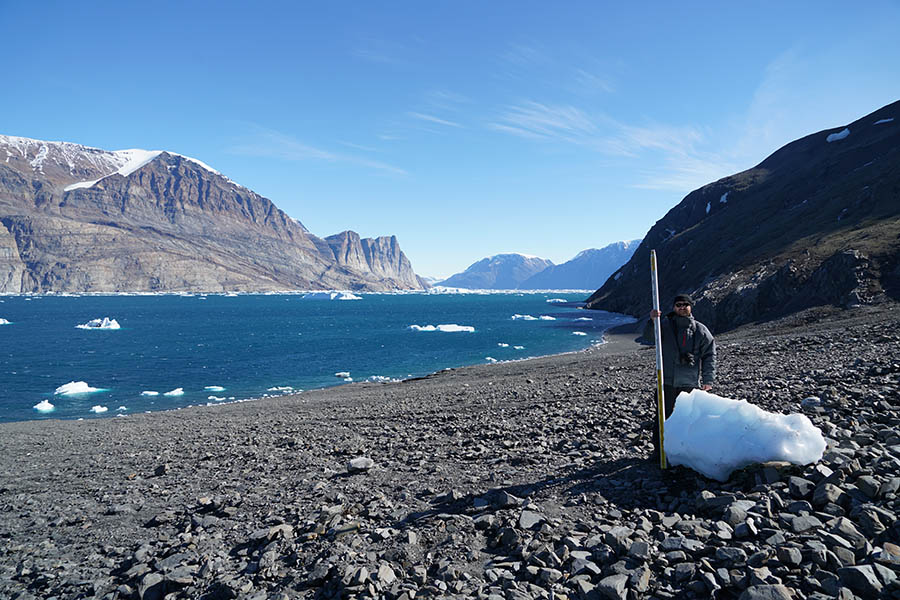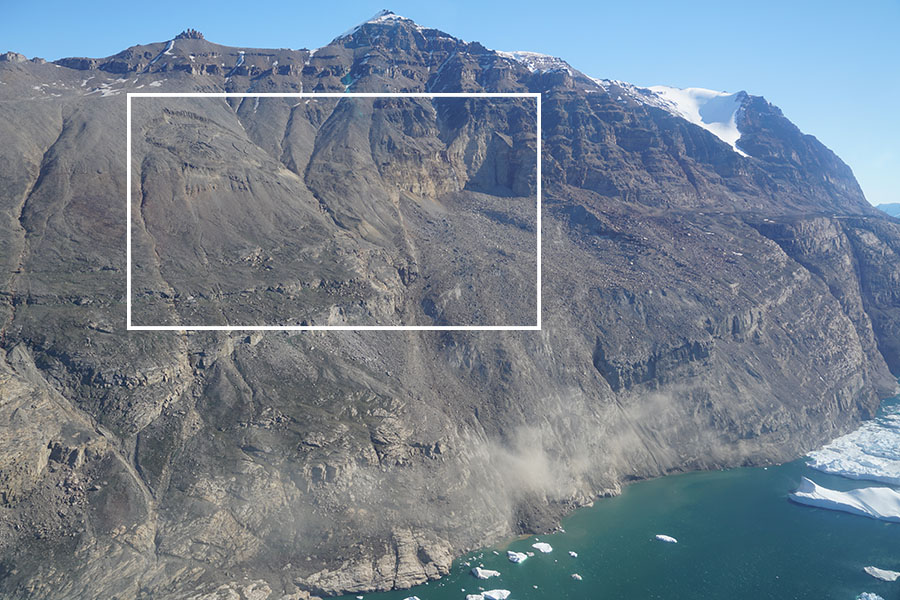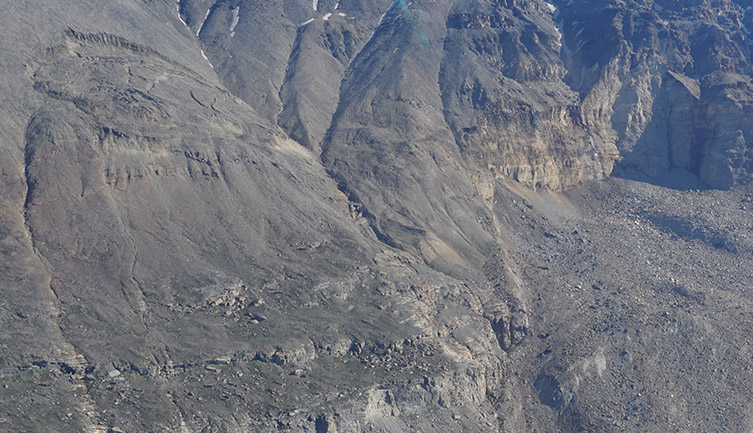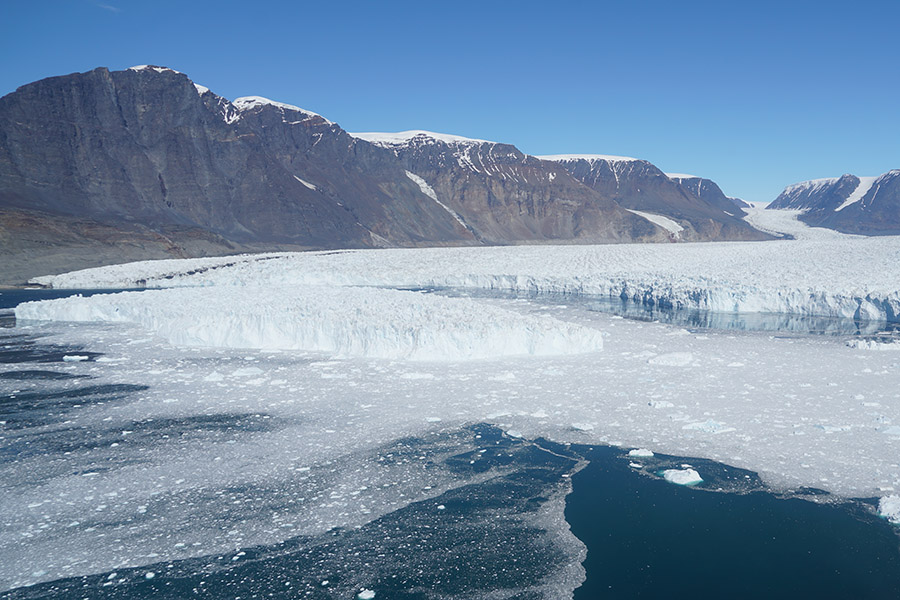
 University of Oregon volcanologist Thomas Giachetti stands with an iceberg washed ashore by a landslide-generated tsunami in Greenland in June. Giachetti, the School of Civil and Environmental Engineering's Hermann Fritz, and Scott Anderson of BGC Engineering collected data to create a 3-D model and assess the size of the landslide and resulting tsunami. The research team found water reached as high as 90 meters (300 feet) along the coastline. (Photo: Hermann Fritz) |
A massive June landslide in Greenland spawned a tsunami that shattered chunks of a glacier and sent water more than 90 meters (300 feet) up the sides of a fjord.
That preliminary data comes from Georgia Tech Professor Hermann Fritz and a reconnaissance team that has just returned from a trip to the site of the landslide and tsunami to collect important perishable data about the disaster. The tsunami wrecked towns along the coast of Greenland and washed away at least four people and several houses.
It’s a particularly unique situation because the landslide plunged into the ocean while another nearby slide remains active but did not fall, creating an ongoing hazard that’s keeping residents of three villages evacuated.
“The second adjacent landslide remains a hazard, with an open back scarp and wide cracks a thousand meters above the water,” Fritz said. “We had an unusual opportunity to record the aftermath of one landslide and tsunami and the baseline of a potential future event.”
 |
 Top: The right half of the highlighted area shows the scarred hillside in Greenland's Karrat Fjord after a landslide fell a kilometer (about 3,300 feet) into the water below, causing a tsunami that reached 300 feet high and has been blamed for four deaths in a nearby town. To the left, another landslide remains active and three towns remain evacuated. Below: A closer look at the two landslides, which more clearly shows the scar and where a landslide has started to separate from the hillside. “We had an unusual opportunity to record the aftermath of one landslide and tsunami and the baseline of a potential future event," said Hermann Fritz, a School of Civil and Environmental Engineering professor who led a reconnaissance team to Greenland this month to collect data about the landslide and tsunami. (Photos: Hermann Fritz) |
The research team found water reached as high as 90 meters along the coastline on the same side as the landslide and 50 meters directly across the Karrat fjord. Both well exceed the 40-meter height, or runup, reached by the 2011 tsunami in Japan.
Fritz said that indicates the tsunami waves were initially very tall, but they dissipated quickly as the wave crossed the fjord.
“The essentially undisturbed semi-circle spreading of the tsunami waves results in massive decay of the surveyed tsunami runup heights compared to the initial tsunami height,” he said.
With the support of the National Science Foundation, Fritz traveled July 5-10 with University of Oregon volcanologist Thomas Giachetti, and geotechnical engineer Scott Anderson of BGC Engineering to collect data about the disaster and create a 3-D reconstruction of the landslide. Anderson also serves on the steering committee of the Geotechnical Extreme Events Reconnaissance Association, which endorsed the data-gathering effort in concert with the local authorities in Greenland.
Fritz said the team wanted to collect important data about the tsunami’s reach and impacts before it, quite literally, melts. Icebergs washed ashore by the tsunami are already shrinking rapidly. They also wanted to understand why four people were swept out to sea while other residents were able to avoid the danger and record video of the tsunami coming ashore.
“At these depths, tsunami waves travel about the length of a football field every second, so the tsunami wave arrived very fast — probably on the order of five minutes for this village 30 km away. That left very little time to react,” Fritz said. “The combination of a small earthquake from the plunge of the landslide, the sound, and unusual iceberg motion in the fjord prompted a spontaneous self-evacuation.”
 |
|
| An iceberg floats in a fjord in Greenland. Researchers believe it broke off the nearby glacier when a powerful tsunami ripped through the fjord. Right: An iceberg sits in the middle of a house in Nuugaatsiaq, Greenland. (Photos: Hermann Fritz) | |
Initially, authorities couldn’t pinpoint the cause of the tsunami, Fritz said. It wasn’t until video and images captured by the Danish Navy and other responders revealed scarring a full kilometer up the steep slopes of the fjord that it became clear what generated the tsunami.
Fritz said the event is reminiscent of a 1958 landslide-generated tsunami in Lituya Bay, Alaska, that he has studied extensively. The narrow fjord and shallow water in the bay resulted in the highest tsunami runup in recorded history.
The Greenland landslide, by contrast, plunged into deeper water and a much larger fjord system. Yet preliminary estimates show the Greenland landslide had at least as much — and maybe greater — volume than the Lituya Bay rockslide.
